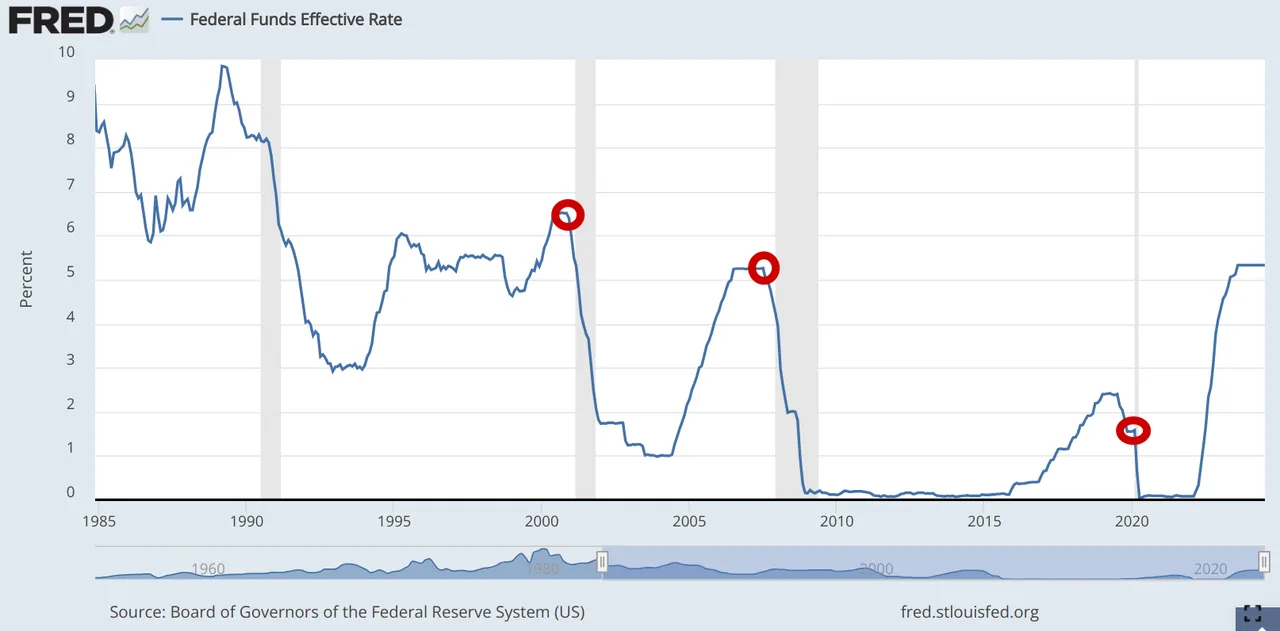Sometimes it's interesting to imagine what the future landscape of cryptocurrency might look like. Is the entire market going to zero against the dollar, will all "shitcoins" consolidate on a Bitcoin standard, or are we headed towards a multi-chain crypto-powered economy?
An important skill any investor needs to learn is recognizing the difference between speculative and fundamental value, and this especially applies in the nascent cryptocurrency space. In this article, we are going to examine one of the most important aspects behind any currency's value.

The Failing US Dollar
Before the outsourcing of their manufacturing base to China and other developing nations, America was a world leader in the production of real goods and services. Thanks primarily to its economic dominance, the US dollar became the world reserve currency in 1944. For nearly a century, international trade has been settled in $USD, but now the dollar's dominance is in serious jeopardy.
What happened?
In addition to the aforementioned hollowing of its manufacturing base, America made a pivotal move in 1971 when Richard Nixon dropped the gold standard, and set the nation off on a path towards infinite credit creation (money printing). America's economy was primed for financialization, a process that took place gradually over the following few decades.
The Fed "put" was created after the Black Monday stock market crash that devastated traders in October 1987. Acting Fed chairman Alan Greenspan came to the rescue, lowering interest rates and promising to keep the markets stable. Ever since then, investors have become increasingly dependent on the Fed to bail them out whenever trouble showed up:
- 2000 Dot Com Bubble Burst
- 2008 Financial Crisis
- 2020 Covid Helicopter Money

The Fed cut interest rates progressively lower after each crisis, cheapening the cost to borrow money and exponentially expanding the debt. Increasing credit isn't necessarily a problem - if it's allocated properly. The issue is that rather than fueling real production of goods and services, the freshly issued credit (money) ended up propping up stock markets and real estate instead.
This built-up debt monstrosity has become a burden on real-world economic development, sucking up capital to service interest payments, instead of funding new manufacturing infrastructure. Even if we choose to trust the GDP numbers released by the government, the real economy has been growing only modestly in recent years.
Despite America's loss of manufacturing and the financialization of their economy, the US dollar still remains the world reserve currency to this day. This is mainly due to the country's worldwide military dominance, and the decades-long entrenchment of the US dollar into international trade.
That said, de-dollarization is accelerating as more nations realize there's very little economic activity backing the USD. When the production backing the dollar was replaced with consumerism and financialization, its fate was sealed. The dollar's demise has only been hastened by its weaponization against Russia, and the US government's increasingly reckless spending bills.
The Trustless Protocol
Before we cover the importance of economic activity on a blockchain, let's go over why Bitcoin is causing a paradigm shift in finance.
The key revolution behind Bitcoin is its trustlessness. What does that mean?
On a Bitcoin standard we no longer have to trust the government or banks to accurately report their balance sheets, as audits are handled automatically on the blockchain. Additionally, unlike fiat currencies that are printed on the whims of central bankers, the supply of Bitcoin is programmed and predictable.
I think the true benefits of Bitcoin and blockchain technology won't be fully appreciated until the banking system suffers from a catastrophic failure (due to unsustainable debt levels), causing the population to lose faith in traditional institutions and seek a better alternative.
When that finally happens, I believe we will abandon the trust-based fiat economy in favor of a new trustless crypto-powered economy, followed by a dramatic revaluation of assets that have been mispriced due to decades of misallocated capital.
Now what do I mean by "crypto-powered economy"?
The Limits Of Bitcoin and Ethereum
Bitcoin had been experiencing economic growth up until 2017 when the core developers chose to cap its block size at 1MB, in effect limiting the network to 7 transactions per second, and causing fees and wait times to surge. Up until that point, an increasing number of businesses and small merchants had been adopting Bitcoin as a payment method.

You maybe be wondering, why does the price of Bitcoin continue to rise, despite its restricted economic activity? One could argue that the primary reason behind Bitcoin's surge (in USD terms) was the massive liquidity injections by central banks, and the recent approval of ETFs, which have opened the floodgates of institutional capital.
In 2014 Ethereum introduced smart-contracts, allowing innovations such as NFTs, DeFi loans, and decentralized exchanges (DEXs). The economic activity on Ethereum was also accelerating until Crypto Kitties handicapped the network in late 2017, causing fees to spike, and discouraging new users from participating in the ecosystem. Despite its economic limitations, Ethereum's price has also been rising thanks to unlimited central bank credit and ETFs.
We have seen that high fees on Bitcoin and Ethereum dampen on-chain economic activity, so what is the solution? In my personal experience, the Lightning Network has become more reliable in recent years, but we still don't know if its secure enough to hold a significant portion of the world's wealth. On Ethereum we have seen the launching of layer 2 solutions, which are essentially siphoning economic activity from the mainnet into their own tokens/blockchains.
Considering the limitations of these first-generation blockchains, what other platforms might have the potential to underpin future economic activity?
Democratized Content
Here on the HIVE blockchain there is a digital economy of users posting, commenting and curating a variety of articles, artwork, and photography. As bloggers contribute to this universally accessible dataset they are rewarded in HIVE and other tokens, which capture the value of the economic activity.

This democratized data is available to all of humanity, instead of being siloed at tech giants like Facebook and Google, where the same people who mandated mRNA gene therapy on you are probably training their advanced AI with your personal data.
Meme Coins and NFTs
While we may not like to admit it, Solana has been producing a lot of economic activity as well, and has become the goto platform for trading NFTs and meme coins.
While many people scoff at the idea of trading NFTs, we have to remember that value is subjective. We could also claim that trading physical sports cards is pointless, but a lot of people find value in it.
In the crypto world, owning a particular set of NFTs or having a large position in a meme coin is a badge of honor for some degens, and who are we to judge that? Whether we like it or not, the trading of NFTs and meme coins is digital economic activity, and Solana is currently at the forefront.
Perhaps the more interesting development on Solana is the hosting of decentralized physical infrastructure network (DePIN) projects that are using crypto incentives to build out infrastructure in the real world.
DePIN
Look at Helium and Hivemapper, for example. These projects are using token incentives to build out decentralized wireless networks and road mapping vehicle fleets. Although the initial token allocations and potential for censorship are valid concerns, we cannot deny that these projects are generating real-world economic activity based on a cryptocurrency.
The DePIN sector isn't limited to the Solana blockchain either. There are similar projects being built in the Ethereum and Cosmos ecosystems as well, and a lot of these projects could end up operating on their own application-specific blockchains in the future.

Real World Assets
Let us not forget about the progress being made on tokenizing real world assets (RWA). Imagine if all physical land, real estate, and vehicles were tokenized as NFTs on censorship-resistant blockchains. The ownership of land titles, houses and cars changes frequently, and we could capture that economic activity on blockchains.
Decentralized Exchanges
There are also decentralized exchanges (DEXs) like Uniswap, Quickswap and Jupiter that are facilitating the trustless exchange of tokens on their respective platforms. In the future, it wouldn't be a stretch to see an individual trading their well-earned Helium tokens in exchange for Hivemapper tokens to gain access to mapping data.
There are also cross-chain DEXs like THORchain, Maya Protocol and Chainflip that facilitate the trustless trading of coins between different blockchain ecosystems. For example, using THORChain, a person could trade their Bitcoin for DVPN tokens in the Cosmos ecosystem in order to pay for their VPN subscription.
The beauty of everything being based on censorship-resistant blockchains is that we can verify economic indicators such as active accounts, transaction count, and total value locked ourselves, instead of relying on government agencies to tell us how well the economy is doing.
Potential Pitfalls
While the idea of re-engineering our economies based on blockchains is indeed exciting, we need to keep our eyes peeled for potential pitfalls.
The blockchains that power the economic activity of tomorrow will need to be sufficiently censorship-resistant and maintain predictable supply curves, otherwise we may as well go back to traditional finance and centralized databases.
Also, an extremely uneven distribution of tokens could negatively impact the network long-term. Blockchains that have allocated too much of the supply to venture capitalists and insiders could be subject to community forks in the future.
From Untrustworthy To Trustless
The financial elite who siphon wealth from the commoner via offshoring, unconventional monetary policy, and financialization have a new challenge on their hands.
Not only are the coins of censorship-resistant blockchains trustless, they are also being harnessed to incentivize the growth of new digital and real-world economies.
A core aspect behind any currency's value is its underlying economic activity. If that activity is removed or throttled, the long-term value of the currency comes into question.
The cryptocurrencies that retain value after fiat currency is long-gone will not have been fueled by speculation, but will rather have served as the base layer of real economic activity.
If you found this article interesting, be sure to check out my other posts on crypto and finance here on the HIVE blockchain. You can also follow me on InLeo for more frequent updates.
Until next time...
Resources
Image Generation Courtesy Of Venice AI [1]